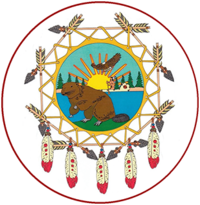
The Cree are a North American Indigenous people. They live primarily in Canada, where they form one of the country's largest First Nations.

The Chipewyan are a Dene Indigenous Canadian people of the Athabaskan language family, whose ancestors are identified with the Taltheilei Shale archaeological tradition. They are part of the Northern Athabascan group of peoples, and come from what is now Western Canada.
In Canada, an Indian reserve is defined by the Indian Act as a "tract of land, the legal title to which is vested in His Majesty, that has been set apart by His Majesty for the use and benefit of a band." Reserves are areas set aside for First Nations, one of the major groupings of Indigenous peoples in Canada, after a contract with the Canadian state, and are not to be confused with indigenous peoples' claims to ancestral lands under Aboriginal title.

The Dane-zaa are an Athabaskan-speaking group of First Nations people. Their traditional territory is around the Peace River in Alberta and British Columbia, Canada. Today, about 1,600 Dane-zaa reside in British Columbia and an estimated half of them speak the Dane-zaa language. Approximately 2,000 Dane-zaa live in Alberta.
First Nations in Alberta are a group of people who live in the Canadian province of Alberta. The First Nations are peoples recognized as Indigenous peoples or Plains Indians in Canada excluding the Inuit and the Métis. According to the 2011 Census, a population of 116,670 Albertans self-identified as First Nations. Specifically there were 96,730 First Nations people with registered Indian Status and 19,945 First Nations people without registered Indian Status. Alberta has the third largest First Nations population among the provinces and territories. From this total population, 47.3% of the population lives on an Indian reserve and the other 52.7% live in urban centres. According to the 2011 Census, the First Nations population in Edmonton totalled at 31,780, which is the second highest for any city in Canada. The First Nations population in Calgary, in reference to the 2011 Census, totalled at 17,040. There are 48 First Nations or "bands" in Alberta, belonging to nine different ethnic groups or "tribes" based on their ancestral languages.
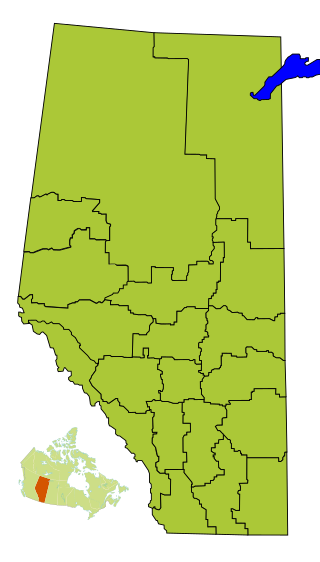
Division No. 17 is a census division in Alberta, Canada. It spans the central and northwest portions of northern Alberta and its largest urban community is the Town of Slave Lake. Division No. 17 is the largest census division in Alberta according to area and also has the lowest population density.

The Bigstone Cree Nation is a First Nations band government in Alberta, Canada. As Woodland Cree, they are a western branch of the larger Cree nation, and are a party to Treaty 8 with Canada. The Bigstone Cree Nation was divided into two bands in 2010, with one group continuing under the former name, and the other becoming the Peerless Trout First Nation.

The Fort McKay First Nation (FMFN) is a First Nations government in northeast Alberta comprising five Indian reserves – Fort McKay 174, Fort McKay 174C, Fort McKay 174D, Namur Lake 174B and Namur River 174A. The FMFN, signed to Treaty 8, is affiliated with the Athabasca Tribal Council and its members are of Cree, Metis and Dene heritage. The FMFN's traditional lands include portions of the Athabasca oil sands.

Ahtahkakoop First Nation is a Cree First Nation band government in Shell Lake, Saskatchewan, Canada. The Ahtahkakoop First Nation government and community is located on Ahtahkakoop 104, 72 kilometers northwest of Prince Albert and is 17,347 hectares in size. The community was formerly known as the "Sandy Lake Indian Band", a name which is still used interchangeably when referring to the reserve.
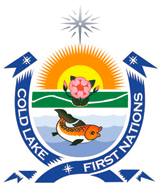
The Cold Lake First Nations is a First Nations band government. This band is the governing body for people descended from several different historic groups, hence the plural, nations, used in the band's name. In August 2019, there were 2,960 members of this band, of which 1,322 lived within five reserves, about 220 square kilometres (85 sq mi) large within the province of Alberta.

The Woodland Cree First Nation is a First Nation in Alberta, Canada adjacent to the Cadotte Lake in Northern Sunrise County northeast of the Town of Peace River. The hamlet of Cadotte Lake is located within the reserve.
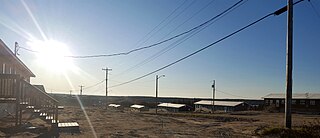
Marcel Colomb First Nation (MCFN), Band #328, is a First Nations Band of approximately 449 Registered Swampy Cree and Rocky Cree (Asinīskāwiyiniwak) located in the area of Lynn Lake, Manitoba, Canada. Marcel Colomb First Nation is affiliated with the Swampy Cree Tribal Council.

The Sturgeon Lake Cree Nation is a First Nations band government or "band", part of the Cree ethnic group, a member of the Western Cree Tribal Council, and a party to Treaty 8. The band controls three Indian reserves, the large Sturgeon Lake 154 and the smaller 154A and 154B. It is based on the shores of Sturgeon Lake, around Calais, west of Valleyview, in the M.D. of Greenview in the Peace Country of Northern Alberta. The registered population of the band is 3,064, of those 1,407 are on the band's own reserves.

The Beaver Lake Cree Nation is a First Nations band government located 105 kilometres (65 mi) northeast of Edmonton, Alberta, representing people of the Cree ethno-linguistic group in the area around Lac La Biche, Alberta, where the band office is currently located. Their treaty area is Treaty 6. The Intergovernmental Affairs office consults with persons on the Government treaty contacts list. There are two parcels of land reserved for the band by the Canadian Crown, Beaver Lake Indian Reserve No. 131 and Blue Quills First Nation Indian Reserve. The latter reserve is shared by six bands; Beaver Lake Cree Nations, Cold Lake First Nations, Frog Lake First Nation, Heart Lake First Nation, Kehewin Cree Nation, Saddle Lake Cree Nation.

The Horse Lake First Nation is a First Nations band government west of Hythe in northwestern Alberta, Canada. It consists of the Beaver and Cree people. It is a party to Treaty 8, and is a member of the Western Cree Tribal Council. Despite being a member of the Western Cree regional council, the Horse Lake First Nation is linguistically and culturally a part of the Danezaa or "Beavers".
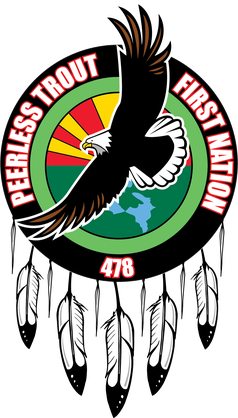
The Peerless Trout First Nation is a First Nations band government in northern Alberta, Canada, that is based out of Peerless Lake. It is part of the Treaty 8 Confederacy and was formed as Alberta's forty-fifth First Nation in 2010.
Saddle Lake Cree Nation is a Plains Cree, First Nations community, located in the Amiskwacīwiyiniwak region of central Alberta, Canada. The Nation is a signatory to Treaty 6, and their traditional language is Plains Cree.
Duncan's First Nation is a First Nation in northwestern Alberta, Canada. It operates as an Indian band under the Indian Act representing a community of Aboriginal Canadians, in this case from the Woods Cree ethnic group. The band became a party to Treaty 8 with the Canadian Crown on July 1, 1899. Indian reserves were surveyed for the band in 1905, but the reserves were not confirmed by Order-in-Council until 1907 and 1925. All but one reserves (#151A) were later surrendered to the Canadian government in 1928. One of them, #151K, was later returned to the band in 1965. The two remaining reserves are #151A, located 52 kilometres (32 mi) west of Peace River, Alberta and #151K, located in the McLennon/Reno area, southeast of Peace River. The two reserves comprise a total area of 2,426.1 hectares, and the majority of the population lives on #151A. In 2012, the band had a registered population of 269, of whom 142 members living the band's reserves.
